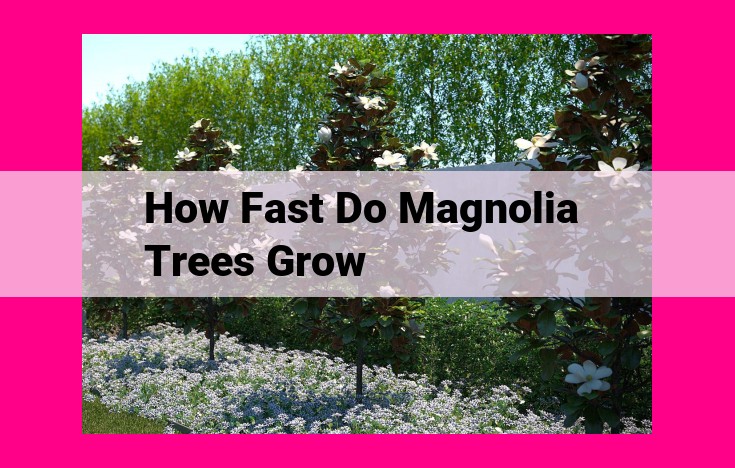Magnolia Tree Growth Guide: Optimize Growth Rate And Care

Magnolia trees exhibit a steady growth rate, with most species adding around 1-2 feet per year. Their growth can vary depending on the species and environmental conditions. They thrive in acidic soil with good drainage and prefer full sun to partial shade. Proper planting techniques, including optimal spacing and hole depth, are crucial for successful growth.
Flowering Brilliance: Magnolia’s Enchanting Bloom
Step into nature’s grand tapestry, where the remarkable blooming season of magnolia trees unfolds. These majestic trees burst forth with an explosion of colors, captivating the senses with their enchanting fragrances.
During their blooming season, magnolias display a kaleidoscope of hues. From the delicate pale pink of the saucer magnolia to the vibrant deep purple of the royal magnolia, these flowers paint the landscape in a breathtaking array. Their velvety petals unfurl with an ethereal grace, resembling the finest silk.
As you stroll beneath these blooming sentinels, the air sweetens with an intoxicating perfume. Magnolia flowers release a heady fragrance, enticing pollinators and leaving a lingering scent that lingers in the memory. Their alluring aroma is a symphony of floral notes, ranging from citrusy to spicy, creating an unforgettable sensory experience.
Steady Growth: Understanding Magnolia Tree Growth Patterns
Like graceful dancers taking their time on stage, magnolia trees embark on a journey of steady growth, adding to their charm and beauty year after year. Their average growth rate is a testament to their patient nature, typically spanning 1 to 2 feet per year.
Species Specificities:
However, like all living beings, magnolia trees are individuals, and each species has its own unique growth rhythm. For instance, smaller varieties such as the dwarf magnolia (Magnolia grandiflora ‘Little Gem’) may only grow a modest 1 foot annually, while larger species like the bull bay magnolia (Magnolia grandiflora) can stretch up to 2.5 feet in the same time frame.
Environmental Influences:
The environment plays a crucial role in shaping the growth rate of magnolia trees. Sunlight is a key factor, with trees receiving ample sunlight showcasing more vigorous growth than their shade-loving counterparts. Soil conditions are equally important, with well-drained, fertile soils fostering faster growth rates.
In conclusion, magnolia trees’ steady growth is a reminder of their resilience and perseverance. Their grace and beauty are not only a feast for the eyes but also a testament to the power of patient nurturing, both in nature and in life.
Environmental Sanctuary: Magnolia’s Ideal Habitat
Soil pH and Nutrient Requirements
The soil in which magnolia trees thrive is a delicate balance of pH and nutrients. Acidic soils, with a pH ranging from 5 to 6, are most suitable for these elegant beauties. Within this ideal pH range, the roots efficiently absorb essential nutrients such as nitrogen, phosphorus, and potassium. These elements are vital for strong growth, vibrant blooms, and overall tree health.
Sunlight Exposure
While magnolias appreciate sunlight, they prefer the filtered light of a partial shade. Direct sunlight exposure, especially during the scorching summer months, can scorch the delicate leaves, hindering healthy growth. The filtered light under a canopy of taller trees or a strategically placed shade structure provides gentle illumination that fosters optimal development.
Temperature Zones
Magnolia trees flourish within specific temperature zones. Most varieties thrive in temperate climates, where winter temperatures rarely dip below 15 degrees Fahrenheit and summer temperatures remain below 90 degrees Fahrenheit. These temperature ranges allow for proper dormancy during the cold season and prevent heat stress during the warm months.
Cultivation Chronicles: A Guide to Nurturing Magnolia Trees
As the days grow warmer and spring’s arrival draws near, magnolia trees emerge from their winter slumber, heralding the season with a symphony of vibrant blooms. From the earliest Star Magnolia to the late-blooming Southern Magnolia, each species weaves its own tapestry of color and fragrance upon the landscape.
To capture the extraordinary beauty of these magnificent trees in your own garden, embark on a journey of cultivation and care. The first step lies in understanding the diverse methods of propagation. Grafting, the technique of joining two plant tissues together, allows you to create new trees with specific characteristics, such as the desired flower color or growth habit. Alternatively, rooting, where a section of a branch is encouraged to develop its own root system, provides a more natural method of propagation.
Once you have chosen your preferred method, it’s time to prepare your garden for the arrival of your new tree. Magnolias thrive in well-drained, acidic soil, so ensure that your soil pH falls within the range of 5.0 to 6.5. Amend the soil with organic matter, such as compost or peat moss, to improve its fertility and water retention.
Sunlight plays a crucial role in magnolia growth. Most species prefer full sun to partial shade, receiving at least six hours of direct sunlight per day. However, some varieties, like the Sweet Bay Magnolia, tolerate more shade. Consider the mature size of the tree and the surrounding trees when determining the ideal planting location.
Dig a planting hole that is twice as wide as the root ball and just as deep. Carefully remove the tree from its container and place it in the hole, ensuring that the top of the root ball is level with the surrounding soil. Backfill the hole with a mixture of native soil and organic matter, tamping down gently to remove air pockets. Water the tree thoroughly and spread a layer of mulch around the base to retain moisture and suppress weeds.
With proper care and attention, your magnolia tree will flourish for years to come. Prune as needed to remove dead or diseased branches and maintain the desired shape. Mulch annually to keep the soil moist and fertile. And water during periods of drought to prevent stress.
By following these cultivation chronicles, you will cultivate a thriving magnolia tree that will become a cherished addition to your garden, a living testament to the beauty and resilience of nature.